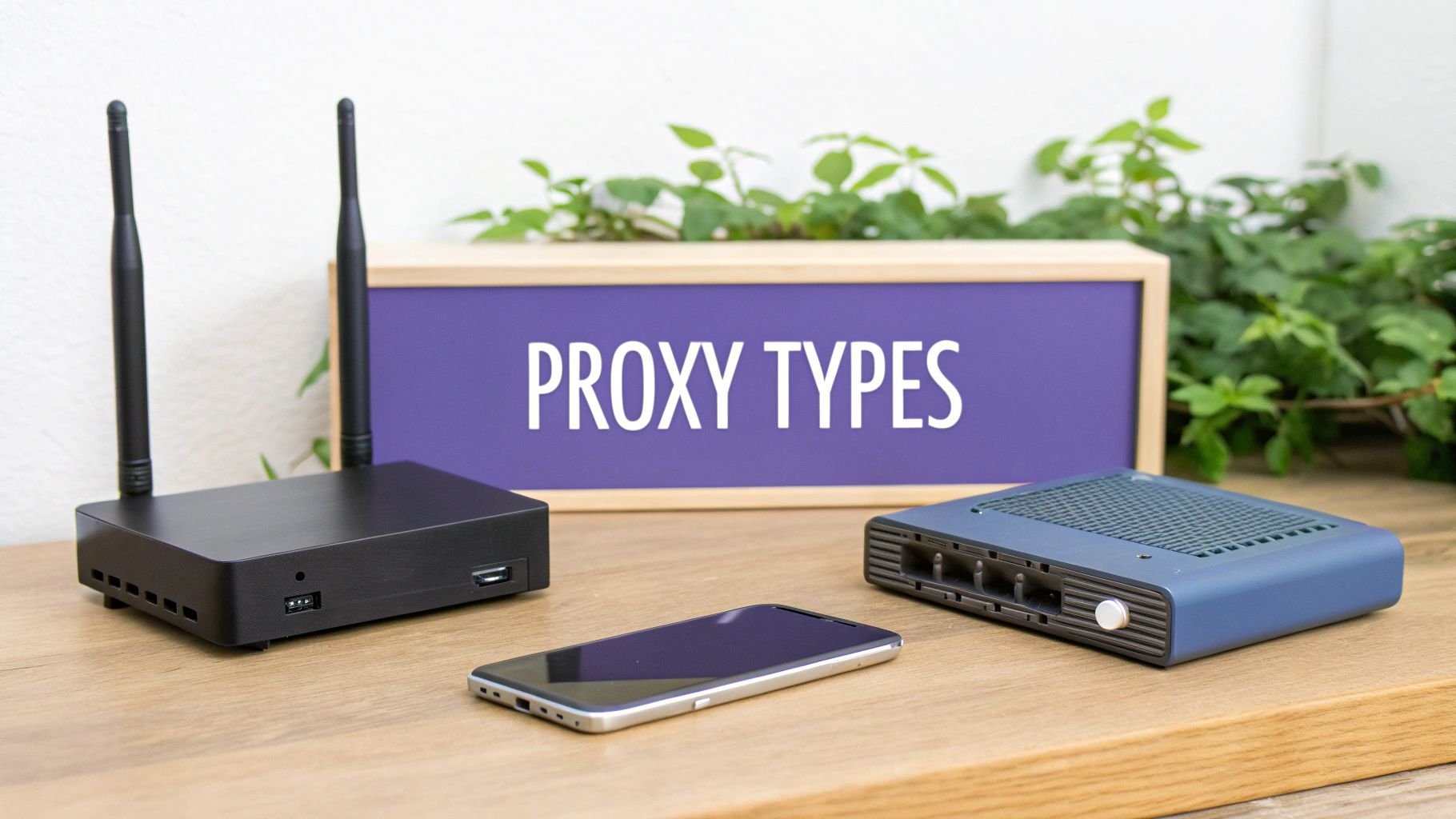Proxy IP rotation is the process of automatically swapping out your IP address for every new connection you make, or after a set amount of time. Think of it like having a different disguise for every door you need to open online—it keeps websites from recognizing you and slamming the door shut. This simple but powerful technique is the backbone of any serious large-scale data gathering operation.
What Is Proxy IP Rotation and Why Does It Matter?

Imagine you’re trying to scrape 10,000 product pages from an e-commerce giant like Amazon. After the first few hundred requests, their security systems would likely flag your single IP address for suspicious activity and block it. Your scraping job would grind to a halt. Websites are built to detect and block a flood of requests from a single IP, viewing it as a potential bot attack.
This creates a huge roadblock for businesses that depend on web data. A marketing firm needs to check thousands of search engine rankings, and an e-commerce store has to monitor competitor prices constantly. To a website, that kind of high-volume activity looks incredibly suspicious, often leading to a swift IP ban that cuts off access to mission-critical information.
The Core Problem Solved by Rotation
This is exactly where IP rotation comes in. It solves the “single IP” problem by giving you a digital cloak of anonymity. Instead of hammering a website from one predictable IP, your requests are spread across a massive pool of different addresses. Each connection looks like it’s coming from a completely new, legitimate user, making it almost impossible for security systems to connect the dots and flag your activity as automated.
This means your operations can run smoothly without interruption, letting you gather the data you need efficiently and at scale.
To put it simply, IP rotation takes the guesswork and risk out of data gathering. Here’s a quick look at the problems it solves and the benefits you gain.
Proxy IP Rotation at a Glance
| Problem Without IP Rotation | Solution with IP Rotation |
|---|---|
| Frequent IP bans and blocks from target sites | Requests are distributed across many IPs, avoiding detection |
| Easy to trace all activity back to one source | Anonymity is enhanced by making requests appear unrelated |
| Limited by your physical location (geo-restrictions) | Access content from anywhere using IPs from different countries |
| High risk of interruptions to data gathering workflows | Ensures continuous, reliable access to online information |
| Operations are easily flagged as suspicious or bot-like | Mimics natural, human user behavior to bypass security |
In short, a solid IP rotation strategy transforms data collection from a risky cat-and-mouse game into a seamless, sustainable operation.
It’s no longer a niche tool for tech wizards but a fundamental necessity for any business that relies on data to make smart decisions.
The market certainly reflects this shift. The demand for reliable rotating proxy solutions is exploding, with the market projected to hit a staggering $10.2 billion by 2033. As more organizations lean on digital information to guide their strategy, the need for uninterrupted data access will only continue to climb. You can dive deeper into the rotating proxy market growth and trends to see just how essential this technology has become.
How Proxy IP Rotation Actually Works
So, what’s happening behind the curtain when you use a rotating proxy? Let’s break it down.

Imagine a massive library filled with millions of different keys. Each key is a unique IP address. This collection of IPs is called a proxy pool, and it’s the heart of any solid rotation strategy. The sheer size of this pool is what makes your online activity look natural instead of robotic.
When you send a request—like scraping a product page or checking a competitor’s site—it doesn’t go straight to the target. It first hits a special server known as a backconnect proxy. Think of this server as a smart traffic director. Its main job is to instantly grab a fresh key (a new IP address) from the pool for your request to use.
The backconnect proxy then sends your request to the target website using that brand-new IP. From the website’s perspective, the request came from that new address, not your real one. This whole switch happens in milliseconds, keeping your operations fast, anonymous, and effective.
The Two Main Rotation Strategies
Not all tasks are created equal, and neither are rotation methods. The way your IPs get swapped out depends entirely on what you’re trying to accomplish. There are two main approaches that determine how often your digital identity changes.
Per-Request Rotation
Think of this as putting on a new disguise for every single action you take. With per-request rotation, every request you send gets a brand-new IP address from the pool. It’s perfect for high-volume, rapid-fire tasks where you need to look like thousands of different users at once.
- Practical Example: A travel aggregator needs to scrape flight prices from dozens of airline websites simultaneously. Using per-request rotation, each price check for a specific route (e.g., JFK to LAX) is sent from a unique IP. This makes the aggregator’s activity indistinguishable from thousands of individual travelers searching for flights.
This high-frequency rotation makes it nearly impossible for a website to spot a pattern because no single IP ever makes more than one or two requests.
By constantly changing the IP address for each connection, per-request rotation effectively mimics the random, distributed nature of real user traffic on a massive scale. This is the key to bypassing most automated detection systems.
Session-Based Rotation (Sticky IPs)
The second approach is session-based rotation, often called “sticky” rotation. In this scenario, you keep the same disguise on for an entire conversation. The system assigns you a single IP address, and you stick with it for a set amount of time—maybe five, ten, or thirty minutes—before it’s rotated out.
This method is critical when you need a consistent identity to complete a task that involves multiple steps.
- Practical Example: Imagine trying to complete an online purchase automatically. You need the same IP to add an item to the cart, navigate to checkout, enter shipping details, and finalize the payment. If your IP changed midway through, the website’s security would likely flag the session as suspicious and terminate it, forcing you to start over. Sticky sessions ensure the entire multi-step process appears to come from a single, consistent user.
Choosing the Right Type of Rotating Proxy

Picking the right tool for the job is everything, and not all proxies are built the same. Your final choice will come down to a balance of speed, cost, and just how much anonymity your project really needs. The world of proxy IP rotation really boils down to three main players: datacenter, residential, and mobile proxies.
Each one has its own strengths and weaknesses, making it a better fit for some tasks than others. Getting a handle on these differences means you won’t overpay for features you don’t need—or worse, get your operation shut down because your proxy wasn’t stealthy enough. Let’s dig into what sets them apart.
Datacenter Proxies: The Workhorses
Think of datacenter proxies as a fleet of commercial vans. They’re fast, cheap, and fantastic for bulk jobs that don’t require you to fly under the radar. These IP addresses come from servers hosted in data centers, not from a typical Internet Service Provider (ISP), so they aren’t tied to a real-world home address.
- Actionable Insight: Use datacenter proxies for scraping websites with simple anti-bot measures, such as online directories or forums. Their speed makes them ideal for quickly collecting large volumes of public data where the risk of being blocked is low.
- Drawback: They are by far the easiest type of proxy for websites to recognize and block.
Residential Proxies: The Undercover Agents
Residential proxies are the equivalent of borrowing your neighbor’s car to run an errand. These are genuine IP addresses assigned by ISPs to actual homeowners, which makes your web requests look like they’re coming from an average person browsing the internet from their couch. That legitimacy is their superpower.
- Actionable Insight: When scraping competitor prices from a major e-commerce site like Nike or Best Buy, residential proxies are non-negotiable. These sites have sophisticated bot detection, and only a real residential IP will bypass their defenses to get accurate, real-time data.
Because residential IPs are tied to real physical locations, they are almost impossible for websites to tell apart from regular user traffic. This gives them an incredibly high success rate for complex data gathering projects. For a deeper look, you can explore this guide on how a residential proxy works.
Mobile Proxies: The Elite Operatives
Finally, we have mobile proxies—the most elite and trusted option you can get. These IPs come directly from real mobile devices connected to cellular networks like 4G or 5G. Since a single mobile IP address can be shared by thousands of users in the same city, websites are extremely reluctant to block them. Doing so could lock out a huge chunk of their legitimate user base.
- Actionable Insight: Use mobile proxies for interacting with mobile-first platforms like Instagram or TikTok. If you are managing multiple accounts or verifying mobile ad displays, a mobile IP provides the highest level of trust and ensures your activities are not flagged.
Comparison of Rotating Proxy Types
To make the choice clearer, let’s break down how these three proxy types stack up against each other. Each one serves a distinct purpose, and seeing them side-by-side helps highlight where each one shines.
| Proxy Type | IP Source | Anonymity Level | Best Use Case |
|---|---|---|---|
| Datacenter | Cloud data centers | Low | High-speed, bulk tasks on simple sites |
| Residential | Real home Wi-Fi (ISP) | High | Scraping secure sites, social media, ad verification |
| Mobile | Cellular networks (4G/5G) | Highest | Mobile app testing, managing mobile-only accounts |
Ultimately, the “best” proxy is the one that fits your project’s specific needs for anonymity, performance, and budget. For simple, high-volume jobs, datacenter proxies are a cost-effective workhorse. But for anything that requires you to look like a real user, residential or mobile proxies are well worth the investment.
Practical Use Cases for IP Rotation in Business

Understanding the mechanics of proxy IP rotation is one thing, but seeing it in action reveals its true business value. This technology is the engine behind many critical data operations, giving companies a competitive edge by unlocking information that would otherwise be completely off-limits.
Let’s move beyond the theory and explore how businesses are applying it to solve real-world problems.
These applications are fueling some serious market growth. The rotating proxy service market is on track to hit $2.5 billion, with an expected Compound Annual Growth Rate of 18% between 2025 and 2033. This surge is driven by the growing need for reliable brand protection, ad fraud prevention, and massive data gathering in sectors like e-commerce and market research.
E-commerce Price Monitoring
In the cutthroat world of online retail, pricing is everything. An e-commerce business needs to know what its competitors are charging, often down to the minute. But what happens when you send thousands of automated requests to a competitor’s site to check prices? You trigger an immediate IP block, cutting off that vital data stream.
By using a pool of rotating residential proxies, a retailer’s price scraping tool can make each request from a different IP address. To the target website, it just looks like thousands of individual shoppers browsing the store. The result is uninterrupted access to real-time pricing data, allowing the business to adjust its own prices on the fly, run smarter promotions, and maximize its market share.
Before: The retailer’s single-IP scraper was constantly blocked, leading to outdated pricing data and lost sales.
After: With proxy IP rotation, they gather accurate, real-time competitor prices daily, enabling a competitive and agile pricing strategy.
Global SEO Strategy and Rank Tracking
Imagine you’re a digital marketing agency with clients all over the world. How do you accurately check their search engine rankings in different countries? A search performed from a server in New York will give you completely different results than one from Tokyo or Berlin.
Geo-targeted residential proxies solve this problem perfectly. The agency can route its rank-tracking queries through IPs located in specific target countries.
- Practical Example: To check how a client’s website ranks for “best running shoes” in Germany, the agency configures its SEO tool to use a German residential proxy. For the same keyword in Australia, it uses an Australian IP. This ensures the search results reflect exactly what a local user would see, providing accurate, location-specific ranking data.
Ad Verification and Brand Safety
Brands pour huge amounts of money into digital advertising, but they need to be sure their ads are being displayed correctly and on appropriate websites. Ad verification platforms use proxy IP rotation to check ad placements from countless different user profiles, locations, and device types.
- Practical Example: A global brand running a campaign wants to ensure its ads aren’t appearing on fake news sites. An ad verification service uses rotating residential proxies from various countries to visit thousands of publisher websites, simulating real users. This allows them to detect fraudulent placements and confirm that the ads are displayed correctly to the intended audience, protecting brand reputation. Many businesses doing in-depth market research use similar data-gathering methods, often supported by various competitor analysis tools.
Social Media Management at Scale
Managing dozens of social media accounts for clients is a standard task for marketing agencies. The problem? Logging into all those accounts from a single IP address is a massive red flag for platforms like Instagram or X (formerly Twitter), often leading to frustrating account suspensions. To see a detailed breakdown of this use case, check out our guide on using proxies for data scraping.
- Actionable Insight: Assign a dedicated “sticky” residential IP to each social media account. This makes it appear as if each account is being managed from a separate, consistent home location, significantly reducing the risk of being flagged for suspicious activity and allowing for safe, scalable management.
Implementing IP Rotation the Smart Way
Getting access to a rotating proxy service is just the first step. The real magic happens when you use it intelligently, making sure your data gathering is efficient, sustainable, and plays by the rules. Just switching on IP rotation without a solid strategy is like flooring it in a race car without knowing how to steer—you’re probably going to crash.
Your main goal should always be to mimic natural human behavior as closely as possible. Real people don’t fire off requests at perfectly timed, robotic intervals. They pause, they click around at different speeds, and their browsing patterns have a natural randomness to them.
Mimic Human Behavior to Avoid Detection
The most common mistake that gets automated tools blocked is predictable, machine-like activity. Even if you have a massive pool of IPs, sending requests every 2.0 seconds on the dot is a dead giveaway. The fix? Introduce a bit of randomness.
- Actionable Insight: Instead of a fixed 2-second delay, program your scraper to wait a random time between 1.5 and 4.5 seconds after each request. This small change makes your request pattern less predictable and more human-like, helping you evade detection.
Another key move is to rotate more than just your IP address. You should also be rotating your User-Agent strings.
A User-Agent is a line of text your browser sends to a website, identifying the browser and operating system you’re using. Sending requests from hundreds of different IPs but with the exact same User-Agent is another huge red flag. By cycling through different User-Agents (like Chrome on Windows, Safari on macOS, etc.), you make each request appear as if it’s coming from a completely different person.
Choose the Right Tool and Handle Errors
Not every website you target will have the same level of security. To get the best results without overspending, you need to match your proxy type to the job.
- For simple targets: Faster, more affordable datacenter proxies are perfect for websites with basic security measures.
- For secure targets: You’ll want to use robust residential proxies for heavily guarded sites like e-commerce platforms or social networks. Their legitimacy is crucial for getting past advanced detection.
Finally, any smart implementation needs a plan for handling errors. When a request fails or an IP gets temporarily blocked, your system shouldn’t just grind to a halt. It needs to be built to automatically retry that request with a fresh IP from your pool. Creating a resilient workflow that expects and manages these small failures is the secret to uninterrupted, large-scale data collection. For more detailed guidance, check out our technical documentation on proxy integration best practices.
Wrapping It Up: Your Path to Uninterrupted Data
So, we’ve covered a lot of ground. It should be clear by now that proxy IP rotation isn’t just some tech-heavy workaround—it’s a core strategy for anyone who’s serious about gathering data from the web.
You’ve seen how it all works, from the different proxy types you can use to how they solve real-world problems like market research and keeping an eye on your SEO. The main thing to remember is that by smartly managing your digital footprint, you can blow past blocks, keep your data clean, and scale up your operations without a hitch. It’s what turns data gathering from a constant headache into a smooth, automated machine.
In a world that runs on data, getting IP rotation right gives you a real, lasting edge. It’s the difference between guessing what your competitors are up to and knowing.
With this guide in your back pocket, you’re now ready to tackle the web’s complexities and pull out the valuable info you need to stay ahead. Think of this as your roadmap to getting non-stop access to the insights that actually fuel business growth. When you put these strategies into play, you’re not just grabbing data—you’re building a smarter, more resilient organization that’s ready for whatever the market throws at it.
Frequently Asked Questions About Proxy IP Rotation
Even after getting the hang of proxy rotation, a few practical questions always pop up. Let’s tackle the most common ones to clear up any confusion and keep your projects running smoothly.
What Is the Difference Between Rotating and Static Proxies
The biggest difference comes down to your digital identity. A static proxy is like having a permanent mailing address—it gives you a single, unchanging IP. This is perfect for tasks that need consistency, like managing a specific social media or e-commerce account where a stable identity is key.
On the other hand, proxy IP rotation is like using a different P.O. box for every piece of mail you send. It assigns you a new IP for each request or after a certain amount of time. This constant change is absolutely essential for large-scale data gathering, as it stops websites from flagging and blocking you for making too many requests from one place.
Is Using Rotating Proxies Legal and Ethical
Yes, using rotating proxies is perfectly legal in most places. The technology itself is neutral. The ethical question boils down to how you use it.
The key is to play by the rules. Respect the terms of service of the websites you visit and comply with data privacy laws like GDPR and CCPA.
Actionable Insight: Before you start any data gathering project, always check the website’s
robots.txtfile and its Terms of Service. Stay away from scraping personal information, and be sure to add delays between your requests so you don’t overload their servers. Ethical use is responsible use.
What Should I Do If My Proxies Get Blocked
It happens. Even with a solid rotation strategy, you might run into a block. When you do, it’s just a sign that you need to tweak your approach.
Here’s a quick checklist to get you back on track:
- Add Random Delays: If your requests are too predictable, they look robotic. Introduce more randomness in the timing between your requests to better mimic how a real person browses.
- Rotate Your User-Agents: Don’t just rotate your IPs. You should also be cycling through different browser and device signatures (User-Agents) to make each request look unique.
- Try a Different Proxy Type: If you’re using datacenter proxies on a high-security website, they might have been spotted. Switching to residential proxies often solves this problem instantly, since they look like genuine user traffic and are much harder to detect.
- Check Your IP Pool: Sometimes, the issue is with the IPs themselves. Your provider might have some flagged addresses in their pool. A quality provider will constantly monitor and refresh its IPs to maintain high success rates.
By working through these steps, you can usually overcome most blocks and keep your operations moving without a hitch.
Ready to unlock uninterrupted data access with a reliable proxy solution? IPFLY offers a premium network of over 90 million residential IPs, ensuring high success rates for all your projects. Get started with IPFLY today!


